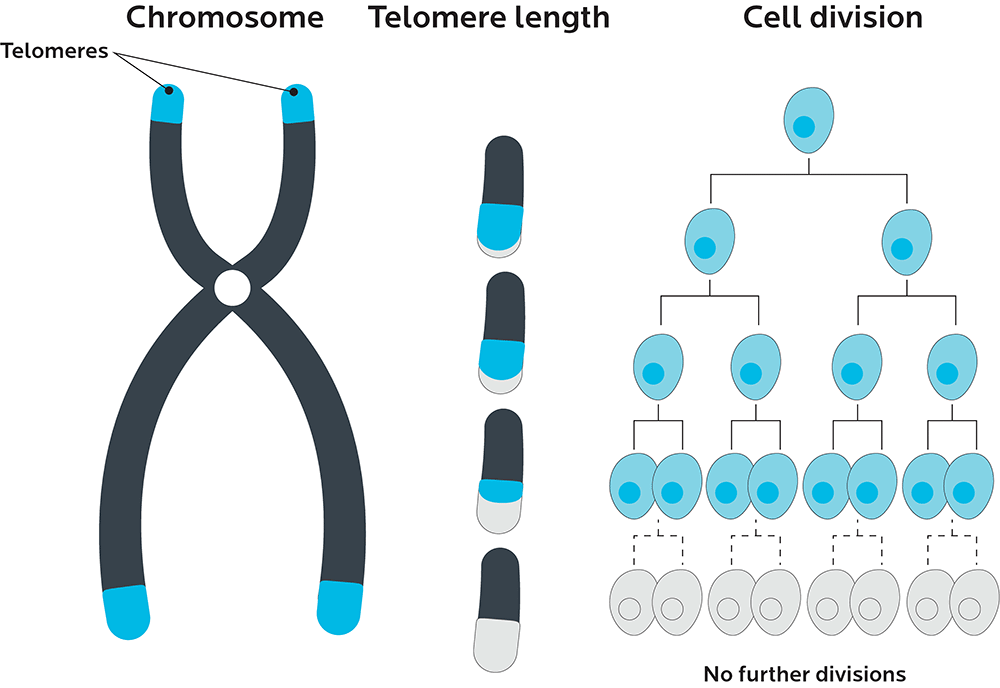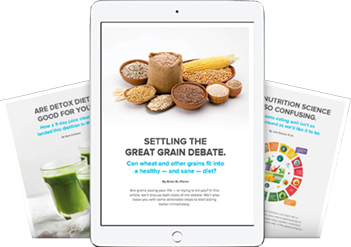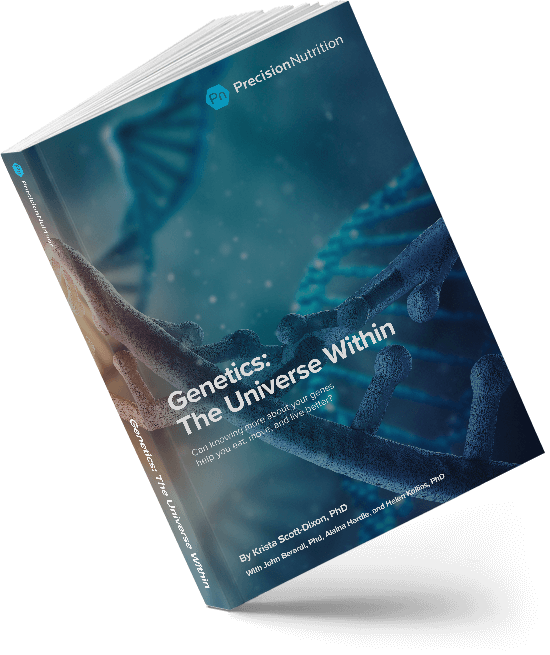Chapter 12
What does this mean for you?
What you’ll learn in this chapter
Wow. You made it all the way through.
Congratulations.
That was heavy stuff, right? A lot to know and remember.
In this chapter, you’ll learn what to do with it all.
Which is:
- Keep your sense of wonder.
- Keep it simple.
- Keep asking good questions.
- Keep practicing the basic good habits that you know are helpful, regardless of your genetic makeup.
- Keep contributing to the cause of science, if you can.
At the edge of possibility
In 1868, Swiss doctor Friedrich Miescher extracted a compound from the nuclei of cells, which he called “nuclein”. Today, we call this DNA, the code of life.
Around this time, Czech monk Gregor Mendel was breeding peas and developing ideas about how these plants inherited their traits.
In 1944, American scientist Oswald Avery created what we might consider the first transgenic bacteria by transferring nuclear material from one type of bacteria to another.
In the early 1950s, British scientists Rosalind Franklin and Maurice Wilkins used X-rays to explore the structure of DNA molecules.
Chemist Linus Pauling took a crack at proposing the shape of DNA as a triple helix.
Eventually, with a landmark research paper in 1953, James Watson and Francis Crick laid claim to the double helix format that we recognize today.
It’s hard to believe it’s been only 64 years since then.
A baby boomer could have been born the day that Watson and Crick published their paper, and not even be old enough to get the senior’s discount at their local movie theater by the time they’re able to enjoy the benefits of genetic science.
We’re writing this book in 2017.
And we are standing on the edge of major scientific discoveries that will forever change the way we think about ourselves. Our connections to a larger ecosystem. And our potential.
We’ve gone from making ball-and-stick models of a molecule that we barely understood to fully mapping the human genome.
Now we can literally watch our cells work. Now we can see DNA “unzip” itself. Now we can look at long tangles of chromatin tucked into tiny nuclei. Now we can see proteins folding.
We can now see processes inside our bodies that previous generations could barely imagine.
We can now create a child with three parents, and treat or even cure diseases that have plagued humanity forever. And we are just a few years away from perfecting the technology that can let us remove genetic diseases or grant additional abilities to our species.
Every day, we discover new genes, new proteins, new pathways, new chemical reactions, new possibilities and opportunities.
Our computing and bioinformatics processing are becoming faster, stronger, more accurate.
And, of course, genetic testing becomes cheaper and more available.
We can speculate about the future. We can imagine great things.
But:
What does this mean for you, right now?
Let’s go back to the fundamental questions we asked earlier in the book.
4 simple questions to ask about genetic testing
You’ll hopefully now remember our 4 questions about how to decide whether a particular genetic test is a good idea.
Is this particular test:
- Descriptive: Does it tell me something about the person being tested?
- Diagnostic: Does it allow me (or a medical professional) to diagnose a problem or characteristic?
- Predictive: Does it allow me to predict some future challenge or occurrence, such as a disease or health risk later in life?
- Prescriptive: Does it tell me what to do next, or in the future?
Hopefully by now you’ve gotten some general ideas about genetics, genetic testing, and how these might relate to your health, fitness, physical makeup, and performance.
We also hope that you’ve gained a new appreciation of how incredible it is to be a complex biological organism with so many moving parts.
There is so much more to learn about genetics.
We are just getting warmed up.
What’s next for you?
Reading through this book, you probably wondered things like:
- What’s in my genes?
- What happens if I discover stuff I don’t like in my genetic test results?
- I got my test results back… how do I make sense of them?
- What am I supposed to do with all this stuff?
- I’m a health and fitness professional… what do I tell my clients about their genetic potential and risk factors?
Here’s our suggested road map through the land of genetics.
There are many ways to navigate this terrain.
This is just one way.
We think it’s a pretty good one, though.
1. If you’re thinking about getting your genetic code tested, start with why.
Get clear on your objectives and reasons.
Ask yourself questions like:
- What would I like to find out? Why?
- What would be useful to me? Why?
- What do I plan to do with the results? Why?
- What am I comfortable with knowing or not knowing? Why?
- What emotional response might I have to my test results? Why?
2. If you’ve already had genetic testing done, start with how.
Understand how things work and what that means.
- How was this sample collected?
- How was the test done?
- How were the results presented?
- How was research and evidence used to support any claims made?
- How were the possibilities and risks discussed?
- How might the results be shaped by the agenda of the testing agency? (In other words, what else is the testing agency looking to sell?)
3. Once you have your results, start with what.
Consider what you need to move forward with what you have learned.
Ask yourself questions like:
- What information is useful, and what is not?
- What does this information mean for how I think about my potential, and my risks?
- Will the results change my future choices? If so, how?
- What more do I need to know in order to make informed decisions?
- What kind of health professional can help me answer the questions I have?
- Who can coach me through my choices in the future, once I know what (if anything) might help me?
Genetics: The game of probability
Few genetic tests offer clarity or certainty.
If you have survived to healthy, functional, and relatively fit adulthood, congratulations! You have probably escaped most of the congenital genetic conditions with major, inevitable effects.
You probably have few “for-sures” in your genetic code.
More likely, you have complex probabilities.
You have possibilities. Maybes. Risks. Could-bes.
Your game, should you choose to play it, is optimizing your genetic potential while reducing your risks.
The problem is, we don’t know exactly what this means for every single genetic combination, or even most individual variations.
However, based on the research we do have, we can say what optimizes some potentials and reduces some risks.
Here are some solid, evidence-based strategies for doing that.
What to do next
Think like a scientist.
Appreciate the complex, wondrous universe of biology.
DNA unites us with all living things in the world. We are all connected.
Your cells carry ancient stories, and at least parts of those stories can also be understood by every other organism — whether octopus or orchid, mouse or mushroom, bird or bacteria.
Be critical, skeptical, and curious.
Ask what evidence supports any claims made.
Be aware of your own biases and desires.
Notice when you may be engaging in magical thinking (“Maybe genetic testing will solve all my problems!”) or becoming emotionally attached to the results that you get.
If you have a mysterious health problem, or are someone who’s always looking for the “edge”, you will naturally want to find solutions, or connect dots that aren’t related.
If you are someone who likes data and exploration, you might also be tempted by the utopian promise of “quantifying the self” and “optimizing” or “hacking” human function.
This isn’t bad. It’s normal.
Simply be aware of your own perspective and potential prejudices.
No amount of testing on its own will change your habits. A genetic result will not somehow scare or motivate you into sustainable behavioral modification.
Expect complexity.
There’s no single, simple explanation.
Distrust “one size fits all” or “one factor explains all” solutions, and people trying to sell you something based on them.
If someone is giving you an answer that sounds too straightforward (such as “You have Gene X, so you should do Exercise Program Y”), that’s probably not the whole picture.
Gather your research team.
If you don’t have enough training to interpret the evidence, look for a genetic counsellor and/or other qualified healthcare provider who is informed and relatively unbiased.
Help research be better.
Share your data, if you’re comfortable.
23andMe asks users to answer survey questions about their experiences, to better correlate the genetic data with what actually happens.
You can also contribute to things like the Personal Genome Project, Human Longevity Inc. (HLI), 1000Genomes, or National Geographic’s Genographic Project.
The more data we gather, the better science works.
Embrace and discover your ancestry.
Recognize that your ethnicity, heredity, and ancestry will affect your results.
Some genetic tests might not even apply to you if your specific ethnic group hasn’t been well-studied.
(And, if possible, demand that your group is studied. Science should not be an elite club.)
Be curious about the paths your ancestors travelled.
A very long and complicated series of events led to you being here right now. Infinite biological equations and social choices had to happen to make you (or even to give you eyes and a brain so you could read this).
Where are your people from? How did they get here?
Learning about your history can add to your own sense of identity and pride.
Be curious about food, movement, and health traditions in the regions where you’re from.
Some traditions may be about convenience or belief. Others may reflect actual data on what has worked in the past for a specific population.
For instance, if people where you’re from never drink milk but always win weightlifting events, this may tell you that your population of origin likely doesn’t have the lactase persistence gene, but could have an inherited tendency for being strong.
Start gathering data for your “Owner’s Manual”.
The “Owner’s Manual” is a concept that we use at Precision Nutrition to help clients and coaches create an individualized, data-based “handling instructions” for themselves and their lives.
An “Owner’s Manual” isn’t a real thing (although it could certainly be if you kept a physical file of your observations). It just means noticing and gathering evidence from your own experiences, and recording it (whether mentally or literally).
Corroborate any genetic test results to observed reality.
If your genetic test says you may have one trait, but you don’t seem to, that’s useful data.
If your genetic test says you may have a high risk for a certain health condition, but you’re not sure, that’s useful data too. Go and get other types of tests done, such as blood work.
Be an informed assessor of your own health and fitness.
Medical tests can be extremely helpful. They can give us an objective picture of what is actually happening in our bodies, based on known and relatively reliable indicators.
At the same time, you can also observe many simple and important indicators on your own. Such as:
- What is your daily energy level like?
- How much pain or inflammation do you have day-to-day?
- How well do you sleep, and for how long?
- What’s your general mood like?
- How’s your digestion?
- How much body fat versus lean mass do you have? (Even if that’s just a general guess.)
- How often do you get sick?
- Are you able to handle physical challenges of daily life? What about more strenuous challenges?
And so on.
In our coaching programs, we teach clients to identify and interpret their own basic physical cues in order to get a simple snapshot of their own overall health.
Exercise regularly.
Recognize that everyone benefits from exercise, movement, and activity.
Regardless of your genetic makeup, your body will work better when you’re consistently active.
For instance, exercise and movement help us:
- stay mobile and functional;
- keep our balance and stay agile, preventing falls;
- manage stress;
- process and partition nutrients (in other words, food does its job properly);
- build lean mass (muscle, bone, and connective tissues);
- keep our brains smart and nervous system responsive;
- prevent age-related muscle loss (aka sarcopenia);
- digest our food better by promoting gastrointestinal motility;
- think in different ways with our kinesthetic “movement brains”; and
- maintain healthy body fat levels.
Exercise can also help us prevent, treat, and/or manage many chronic diseases as well as slow the aging process.
Exercise may be one of the most powerful tools in our toolbox, as it improves almost everything, often relatively quickly.
For instance, exercise:
- may briefly decrease methylation in skeletal muscle;
- increases messenger RNA (mRNA) expression; and
- changes the protein levels of many genes that regulate metabolic factors such as mitochondrial function and fuel use (e.g. PGC-1α, transcription factor A, mitochondrial (TFAM); peroxisome proliferator-activated receptor δ (PPAR-δ); and pyruvate dehydrogenase kinase, isoenzyme 4 (PDK4) and so forth).
At the same time…
Recognize that genetically speaking, not everyone sees exactly the same results from exercise.
So don’t get frustrated or criticize yourself if you’re working hard but not seeing the same results as your buddy who seems to be a “natural” athlete.
Or, if your body “naturally” seems to respond well to exercise, don’t expect other bodies to do the same (especially if you’re a coach who works with all kinds of clients).
Exercise helps us metabolize sugar and fat properly, but we vary genetically in how well or quickly we respond to exercise in this way.
For example:
- One study looked at the rs1801282 variant on the PPARG gene that codes for PPAR-γ, which helps regulate metabolism of glucose and fatty acids. While some people with a particular variant of rs1801282 (also known as the Pro12Ala variant) were better at clearing glucose during exercise, everyone benefited metabolically from exercise.
- In another study, people with the -514C allele of LIPC were more likely to significantly improve their insulin sensitivity if they exercised regularly.
- Various APO genotypes affected people’s lipase (fat-mobilizing enzyme) activity.
And so on.
Other genetic variants may affect a wide variety of exercise results, such as heart rate, vascular function during exercise, and other measures of aerobic performance.
If you have a particular variant of the AMPD1 gene, which codes for an enzyme known as adenosine monophosphate deaminase (one of the enzymes used to process ATP), you might get more muscle pain and cramping during intense exercise. Though you aren’t alone: At least one world-class runner has this variant.
Your body is your body.
And not someone else’s.
Your mileage may vary.
Choose physical activities that suit your body as much as possible.
If you’re looking for the best results possible, then try to match your physical activities to your most informed hypotheses about what your unique body prefers. Over time, gather data about your hypotheses and refine your action plan.
If it’s pretty clear you’re a fast-twitcher, enjoy your strength and power sports, and don’t feel like you “should” be doing distance running.
If it’s pretty clear that you’re a slow-burner, enjoy your endurance sports, and don’t try to beat the world high-jump record. (Well, you can try, just don’t get mad if you don’t succeed.)
Of course, if you enjoy a sport that you aren’t naturally well-suited for, go and have fun doing it. You probably won’t be the best in the world at it, but who cares?
Control what you can control.
We can’t control what mom and dad (or, these days, maybe mom, mom, and dad) gave us.
We also can’t necessarily control many environmental factors, such as airborne pollution, chemical contaminants in our food and water, occupational hazards, early-life trauma, and other things that may affect our epigenetic expression.
We may find ourselves struggling to maintain a healthy body composition if we don’t have the skills and habits to do so, or if we have underlying genetic factors that make this more difficult. Our skeletons may be wider or narrower; denser or lighter; shaped this way or that way.
But, for the most part, we have a fair bit of control over such factors as:
- what we eat;
- whether we drink alcohol;
- whether we smoke;
- what drugs we take (assuming that these are non-life-saving medications, of course);
- how often and intensely we exercise and move around;
- how we respond to daily-life stressors; and
- how and whether we choose to reproduce and pass on our DNA to offspring.
Consider your environment.
You may have heard the expression, “Genetics loads the gun; environment pulls the trigger.”
Now, that’s a bit of a disturbing analogy that makes genetics sound like a professional but ambivalent hitman, but it gives you the idea:
What’s around you matters.
This includes “real things” like chemicals as well as more intangible things like social support. (See below.)
One researcher has coined the term “exposome” to describe all the environmental factors that might affect genetic expression throughout our lives. Environmental stressors (such as pollution, toxic chemicals, medications, or pathogens like viruses) can all affect expression. This, in turn, can affect things like our metabolic health.
Regardless of your genetic makeup, it’s probably not a great idea to stew in a soup of potentially toxic or DNA-altering chemicals.
Look around your immediate environment and consider the products you’re using, and/or what you’re exposed to. Consider whether any of this can be improved.
Consider your ability to respond to stress.
Environmental stressors also affect the length of our telomeres, which work at the ends of our DNA strands like the little caps on the ends of your shoelaces that prevent them getting frayed. (The term comes from the ancient Greek telos, or end, and meros, or part. So telomeres are literally “end parts”.)
The longer our telomeres are, the healthier we’re likely to be, and the less cellular aging we likely have.
Shorter telomeres, on the other hand, indicate more aging and degeneration — again, sort of like a shoelace fraying.
So, how long our telomeres are can tell us about how healthy our DNA is, and how quickly or slowly we’re aging in a biological sense.

Being exposed to environmental stressors like chemicals can shorten our telomeres, but so can social stress.
For instance, a study that looked at women caring for a child with a major disability or serious chronic illness found that the long-term stress of caregiving and worry over a child’s health was linked to shorter telomeres. Feeling socially isolated and lonely can change our genetic expression too.
However, stress isn’t just what’s around us. It’s how we respond to what’s around us.
So even if you’re exposed to a social stressor (such as something bad happening to you as a child), if you can respond resiliently to that stressor and have other people supporting you, you’ll have better DNA health than someone who is isolated and panicking.
If you’re a parent, choose wisely.
When humans and other mammals get ongoing social support in an interesting and engaging environment with a small dose of growth-promoting “good stress”, they thrive.
Parents can play a major role here, not just in offering their own genetic material, but also in creating surroundings that help their children optimize their epigenetic expression.
For instance:
- Build your own healthy habits. Many of our clients come to us because they’ve decided to be healthy role models for their children. And, as a parent (especially if your children are younger and they live with you), you can shape their food and activity choices… which will be a lot easier if your own fundamental habits are in place.
- Make wise choices before conception and during pregnancy. This goes for you too, dad. Both parents’ genetic material can be affected by their own health habits. So if you’re hoping for a baby but haven’t gotten started on the project yet… start building those healthy habits now. And, of course, if you’re currently pregnant, choosing healthier options will improve what’s known as the maternal effect — the role that the mother plays in her offspring’s epigenetic expression. (More on this below.)
- Introduce your child to a wide range of tastes. (If you’re currently pregnant, try a wide range of tastes yourself.) Evidence suggests both prenatal and early childhood exposure to various foods helps set taste preferences for later on. If you want your kids to eat healthy foods, eat healthy foods yourself, and make them readily available.
- Introduce your child to a wide range of microbes. Research suggests that pre- and post-natal exposure to diverse microbial environments (like bacteria, viruses, and fungi) can change the epigenetics of the immune system. Don’t keep your house too antiseptically clean, and it’s probably OK if your kid licks the dog.
- Be active as a family. Whatever your genetic makeup, we’re healthier when we’re moving, and when we’re connected to other people. Even if you got every single one of the “exercise nonresponder / metabolic disruptor / excess adiposity” genes, you can still (to some degree) change the expression of these, especially if you start as early in life as possible. (But of course, it’s never too late to make some healthy changes.)
- Don’t smoke. This should be obvious, but it’s pretty clear: Smoking changes our epigenetic expression in a bad way. It affects both the smoker and anyone else exposed to secondhand smoke, especially a child with a developing system.
Maternal effects
Although, of course, both parents contribute genetic material to their offspring, given the mother’s role in gestation, she can have a powerful effect on her developing fetus’ epigenetic expression.
In particular, what she eats and the environment she’s in can affect the outcome.
For instance:
- If mothers have persistently high blood sugar (known as hyperglycemia) during pregnancy, this may affect methylation of the fetus’ leptin gene, and potentially the child’s body fat levels as they mature.
- High-fat diets during pregnancy may affect expression of the fetus’ adiponectin genes; in particular, methylation may go up while acetylation may go down. This may mean that later in life, the child may have a higher risk of some types of metabolic problems such as Type 2 diabetes or cardiovascular disease. (It isn’t clear whether the type of fat matters here, though.)
- In a famous study on the effects of undernutrition during pregnancy, offspring of mothers who’d endured the so-called Dutch Hunger Winter famine during WWII showed hypomethylation on the IGF2 gene, later correlated with higher risks of cardiovascular disease.
Along with physical health, mothers’ mental and emotional health is also important.
For instance, the NR3C1 gene codes for the glucocorticoid receptor (GR). Glucocorticoid hormones, such as cortisol, are involved in our stress response and inflammation.
Our stress response is organized by a complex set of feedback loops known as the hypothalamic-pituitary-adrenal (HPA) axis. HPA axis function shapes how we are able to respond to stress, and how generally anxious and physiologically or psychologically reactive we tend to be.
When mothers were anxious, depressed, or otherwise distressed during pregnancy, this often affected methylation of their fetuses’ NGFI-A binding site in NR3C1. This epigenetic change then predicted increases in infants’ HPA stress reactivity.
In other words: A stressed mother may mean a stressed child.
Other research suggests that there are similar links between mothers’ mood or distress level during pregnancy, and their offspring’s epigenetic expression of other genes such as HSD11B2, which codes for a protein that converts cortisol to cortisone and vice versa, as well as protecting other tissues from the damaging effects of corticosteroids.
Of course, as a parent, you can’t control all the factors involved in your child’s epigenetic expression. (See above: Control what you can control.)
Rather than worrying too much about the genetic blueprint you or your child got, focus on how you can help build the best house possible from those blueprints.
What’s next for you?
At Precision Nutrition, our motto is “Life-changing, research-driven nutrition coaching for everyone.”
Genetics (and genetic testing) highlight one of the fundamental tensions of coaching:
- The outer limits of our health, ability, function, and performance are determined by factors outside our control (factors that include genetics).
- At the same time, we have tremendous potential for change, growth, improvement, and adaptation.
So, for instance, a person who is 5 feet tall can learn to run, jump, and throw a basketball better — perhaps even at a world-class level of shot accuracy. But that person will never be able to dunk a basketball like a 7-footer.
At some point, we bump up against our own limits, and some tasks are simply impossible for some people.
On the other hand, most of us will never find most of those limits, because the playing field of our physiology is wider and bigger than we can imagine.
Disciplines that specialize in finding the boundaries of human function and performance have discovered that the human body has far greater resources of recovery, resilience, and capacity than most of us realize.
We contain limits, but also opportunities and potential.
So, if you’re curious about what that looks like for you:
- Treat your body as a set of possibilities rather than limitations. Explore, build, practice, and see what you can do after putting in the reps.
- Consider coaching. Coaches specialize in finding, bettering, and amplifying the raw material you already have.
- Check back on our site for updates. Research is always evolving.
- Be curious. Ask us questions on our Facebook page.
- And, of course: Keep science-ing!






